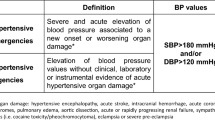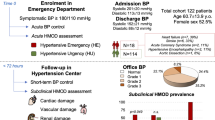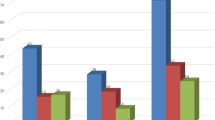Abstract
Objective
To study the clinical significance of presenting blood pressure parameters and heart rate in patients with hypertensive crisis.
Methods
In patients admitted with hypertensive crisis between January 2011 and May 2011, demography, mode of presentation, co-morbidities, blood pressure readings, and heart rate at presentation were documented. Further clustering of hypertensive crisis into emergency or urgency was based on the presence or absence of target organ involvement. The relationship between blood pressure parameters, heart rate, and other variables was analyzed.
Results
189 patients in sinus rhythm were enrolled in this pilot study. The rate of hypertensive urgency was 56 %, whereas the rate of hypertensive emergency was 44 %, respectively. Subjects with hypertensive emergency had a higher mean heart rate (93 ± 22.7 bpm) than those with urgency (81 ± 11.5 bpm) (P = 0.015). Women had higher heart rates (92 ± 18.5 bpm) than men (86 ± 17.6 bpm) (P = 0.014). Heart rates below 100 bpm had a specificity of 94 %, classifying patients as hypertensive urgency. Tachycardia had a powerful statistical association with hypertensive left ventricular failure (P < 0.0001). Other hemodynamic parameters, including systolic blood pressure, diastolic blood pressure, pulse pressure, and mean blood pressure relates neither to urgency nor to emergency. Diabetic patients with HBA1c levels of more than 53 mmol/mol had a heart rate of more than 100 bpm (P = 0.015) during hypertensive crisis.
Conclusions
Normal heart rate is characteristic of hypertensive urgency. Tachycardia in this setting is an ominous sign and denotes hypertensive complications in particular left ventricular failure. Among diabetics, elevated heart rate is associated with poor glycemic control.


Similar content being viewed by others
References
Dzau V, Braunwald E, Participants (1991) Resolved and unresolved issues in the prevention and treatment of coronary artery disease: a workshop consensus statement. Am Heart J 121:1244–1262
Reil JC, Custodis F, Swedberg K, Komajda M, Borer JS, Ford I, Tavazzi L, Laufs U, Böhm M (2011) Heart rate reduction in cardiovascular disease and therapy. Clin Res Cardiol 100(1):11–19
Reil JC, Böhm M (2008) BEAUTIFUL results—the slower, the better? Lancet 372:779–780
Custodis F, Baumhäkel M, Schlimmer N, List F, Gensch C, Böhm M, Laufs U (2008) Heart rate reduction by ivabradine reduces oxidative stress, improves endothelial function, and prevents atherosclerosis in apolipoprotein E deficient mice. Circulation 117:2377–2387
Custodis F, Gertz K, Balkaya M, Prinz V, Mathar I, Stamm C, Kronenberg G, Kazakov A, Freichel M, Böhm M, Endres M, Laufs U (2011) Heart rate contributes to the vascular effects of chronic mental stress: effects on endothelial function and ischemic brain injury in mice. Stroke 42(6):1742–1749
Kannel WB, Kannel C, Paffenbarger RS, Cupples LA (1987) Heart rate and cardiovascular mortality: the Framingham Study. Am Heart J113:1489–1494
Dyer AR, Persky V, Stamler J, Paul O, Shekelle RB, Berkson DM, Lepper M, Schoenberger JA, Lindberg HA (1980) Heart rate as a prognostic factor for coronary heart disease and mortality: findings in three Chicago epidemiologic studies. Am J Epidemiol 112:736–749
Benetos A, Rudnichi A, Thomas F, Safar M, Guize L (1999) Influence of heart rate on mortality in a French population: role of age, gender, and blood pressure. Hypertension 33:44–52
Palatini P, Thijs L, Staessen JA, Fagard RH, Bulpitt CJ, Clement DL, Leeuw PW, Jaaskivi M, Leonetti G, Nachev C, O’Brien ET, Parati G, Rodicio JL, Roman E, Sarti C, Tuomilehto J, Systolic Hypertension in Europe (Syst- Eur) Trial Investigators (2002) Predictive value of clinic and ambulatory heart rate for mortality in elderly subjects with systolic hypertension. Arch Intern Med 162:2313–2321
Fox K, Ford I, Steg PG, Tendera M, Robertson M, Ferrari R (2008) Heart rate as a prognostic risk factor in patients with coronary artery disease and left ventricular systolic dysfunction (BEAUTIFUL): a subgroup analysis of a randomized controlled trial. Lancet 372:817–821
Swedberg K, Komajda M, Böhm M, Borer JS, Ford I, Dubost-Brama A, Lerebours G, Tavazzi L, On behalf of the SHIFT Investigators (2010) Beneficial effects of ivabradine on outcomes in chronic heart failure. The systolic heart failure treatment with the If inhibitor ivabradine trial (SHIFT). Lancet 376:875–885
Böhm M, Reil J-C, Danchin N, Thoenes M, Bramlage P, Volpe M (2008) Association of heart rate with microalbuminuria in cardiovascular risk patients: data from ISEARCH. J Hypertens 26(1):18–25
Janaka K, Giancarlo V (2004) Microalbuminuria and cardiovascular risk. Am J Hypertens 17(10):986–993
Tisdale JE, Huang MB, Borzak S (2004) Risk factors for hypertensive crisis: importance of out-patient blood pressure control. Fam Pract 21(4):420–424
Martin JF, Higashiama E, Garcia E, Luizon MR, Cipullo JP (2004) Hypertensive crisis profile. Prevalence and clinical presentation. Arq Bras Cardiol 83(2):131–136
Al Bannay R, Husain A (2010) Hypertensive crisis: clinical presentation, comorbidities, and target organ involvement. Saudi Med J 31(8):916–920
Al Bannay R, Husain A (2012) Hypertensive crisis: comparison between diabetics and non-diabetics. Int J Cardiol 154(2):198–200
Hebert CJ, Vidt DG (2008) Hypertensive crises. Prim Care 35(3):475–487
Blomstrom-Lundqvist C, Scheinman MM, Aliot EM, Alpert JS, Calkins H, Camm AJ, Campbell WB, Haines DE, Kuck KH, Lerman BB, Miller DD, Shaeffer CW Jr, Stevenson WG, Tomaselli GF (2003) ACC/AHA/ESC guidelines for the management of patients with supraventricular arrhythmias—executive summary. A report of the American college of cardiology/American heart association task force on practice guidelines and the European society of cardiology committee for practice guidelines (writing committee to develop guidelines for the management of patients with supraventricular arrhythmias) developed in collaboration with NASPE-Heart Rhythm Society. Eur Heart J 24:1857–1897
Chobanian AV, Bakris GL, Black HR, Cushman WC, Green LA, Izzo JL, Jones DW, Materson BJ, Oparil S, Wright JT, Roccella EJ, The National High Blood Pressure Education Program Coordinating Committee (2003) Seventh report of the joint national committee on prevention, detection, evaluation, and treatment of high blood pressure. Hypertension 42:1206–1252
Rosei EA, Salvetti M, Farsang C (2011) Treatment of hypertensive urgencies and emergencies. Sci Newslett: Update Hypertens Manage 12(28):55–56
Jones CR, Taylor K, Poston L, Shennan AH (2011) Validation of the Welch Allyn ‘vital signs’ oscillometric blood pressure monitor. J Hum Hypertens 15:191–195
Executive summary: standards of medical care in diabetes—2009. Diabetes Care 32:S6–S12
National Cholesterol Education Program (NCEP) Expert Panel on Detection, Evaluation, and Treatment of High Blood Cholesterol in Adults (Adult Treatment Panel III) (2002) Third Report of the National cholesterol education program (NCEP) expert panel on detection, evaluation, and treatment of high blood cholesterol in adults (adult treatment panel III) final report. Circulation 106:3143–3421
National Kidney Foundation (2002) K/DOQI clinical practice guidelines for chronic kidney disease: evaluation, classification, and stratification. Am J Kidney Dis 39(2 Suppl 1):S1–S266
Okin PM, Kjeldsen SE, Julius S, Hille DA, Dahlöf B, Edelman JM, Devereux RB (2010) All-cause and cardiovascular mortality in relation to changing heart rate during treatment of hypertensive patients with electrocardiographic left ventricular hypertrophy. Eur Heart J 31:2271–2279
Fácila L, Morillas P, Quiles J, Soria F, Cordero A, Mazón P, Anguita M, Martín-Luengo C, Gonzalez-Juanatey JR, Bertomeu V, On behalf of the “The Prevalence of Peripheral Arterial Disease in Patients with Acute Coronary Syndrome” (PAMISCA) Investigators (2013) Prognostic significance of heart rate in hospitalized patients presenting with myocardial infarction. World J Cardiol 4(1):15–19
Knaus WA, Draper EA, Wagner DP, Zimmerman JE (1985) APACHE II: a severity of disease classification system. Crit Care Med 13(10):818–829
Hoke RS, Müller-Werdan U, Lautenschläger C, Werdan K, Ebelt H (2012) Heart rate as an independent risk factor in patients with multiple organ dysfunction: a prospective, observational study. Clin Res Cardiol 101(2):139–147
Bruijns S, Guly H, Bouamra O, Lecky F, Wallis L (2012) Heart rate and systolic blood pressure in patients with minor to moderate, non-haemorrhagic injury versus normal controls. Emerg Med J
Ritter M, Rohde A, Heuschmann P, Dziewas R, Nabavi D, Ringelstein B (2011) Heart rate monitoring on the stroke unit. What does heartbeat tell about prognosis? An observational study. BMC Neurol 11:47
Hasdai D, Behar S, Wallentin L, Danchin N, Gitt AK, Boersma E, Fioretti PM, Simoons ML, Battler A (2002) A prospective survey of the characteristics, treatments and outcomes of patients with acute coronary syndromes in Europe and the Mediterranean basin. Eur Heart J 23:1190–1201
Alhabib KF, Sulaiman K, Al-Motarreb A, Almahmeed W, Asaad N, Amin H, Hersi A, Al-Saif S, AlNemer K, Al-Lawati J, Al-Sagheer NQ, AlBustani N, Al Suwaidi J, Gulf RACE-2 Investigators. Collaborators (2012) Baseline characteristics, management practices, and long-term outcomes of Middle Eastern patients in the second Gulf registry of acute coronary events (Gulf RACE-2). Ann Saudi Med 32(2):9–18
Ma Y, Chilton RJ, Lindsey ML (2012) Heart rate reduction: an old and novel candidate heart failure therapy. Hypertension 59:908–910
Reil JC, Reil GH, Böhm M (2009) Heart rate reduction by I(f)-channel inhibition and its potential role in heart failure with reduced and preserved ejection fraction. Trends Cardiovasc Med 19:152–157
De Ferrari GM, Mazzuero A, Agnesina L, Bertoletti A, Lettino M, Campana C, Schwartz PJ, Tavazzi L (2008) Favourable effects of heart rate reduction with intravenous administration of ivabradine in patients with advanced heart failure. Eur J Heart Fail 10:550–555
Nieminen MS, Brutsaert D, Dickstein K, Drexler H, Follath F, Harjola V, Hochadel M (2006) EuroHeart failure survey II (EHFS II): a survey on hospitalized acute heart failure patients: description of population. Eur Heart J 27(22):2725–2736
Vinik A, Ziegler D (2007) Diabetic cardiovascular autonomic neuropathy. Circulation 115:387–397
Palatini P (2009) Need for a revision of the normal limits of resting heart rate. Hypertension 33:622–625
Conflict of interest
The authors of this manuscript declare no conflict of interests.
Author information
Authors and Affiliations
Corresponding author
Rights and permissions
About this article
Cite this article
Al Bannay, R., Böhm, M. & Husain, A. Heart rate differentiates urgency and emergency in hypertensive crisis. Clin Res Cardiol 102, 593–598 (2013). https://doi.org/10.1007/s00392-013-0570-5
Received:
Accepted:
Published:
Issue Date:
DOI: https://doi.org/10.1007/s00392-013-0570-5




